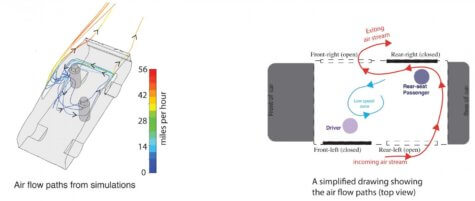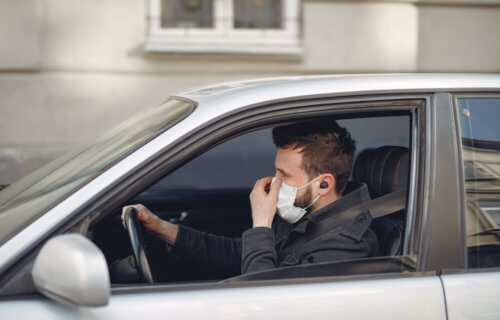AMHERST, Mass. — For anyone traveling inside a taxi or ride-share during the coronavirus pandemic, the anxiety may tempt them to keep their head outside the window the whole time. While rolling down your window may seem like a smart plan to avoid airborne infections, a new study finds there are better strategies to make your car ride virus-free. A physicist from the University of Massachusetts Amherst has made a surprising discovery about how certain window combinations can protect both the driver and a passenger from contaminated airflow.
“One might imagine that people instinctively open windows right beside them while riding with a co-passenger during the pandemic. That may not be optimal – though it’s better than opening no window,” says study lead author Varghese Mathai, an assistant professor of physics, in a university release.
“We designed this research with ride-sharing in mind, from a traditional taxi or Uber and Lyft to noncommercial commutes, assuming a driver and one passenger, seated in the back on the passenger side to provide the best possible spacing between the occupants.”
Car window musical chairs
Both computer modeling and live testing demonstrates how opening different windows in a moving vehicle changes the airflow of the countless particles leaving the human body with each breath. The results show opening the windows farthest from the driver and back-seat passenger can provide some benefits for both travelers.
Overall, study authors conclude the safest strategy is to open all car windows and bring in more fresh air from the car’s vents. This seems to be the best way of increasing ventilation and reducing the risk of transmission.
Unfortunately, as the United States and other countries head into the winter months, this may not be a realistic option. To explore the alternatives, Mathai examined what happens when aerosols (tiny droplets) are exhaled by a vehicle’s occupants with the windows either open and closed.
“These tiny, potentially pathogenic particles remain in the air for long durations without settling down, so if they are not flushed out of the cabin, they can build up over time posing an increased risk of infection,” the researcher explains.
Go with the flow

The study finds that air flowing around a car usually creates a lower pressure on the front windows compared to the rear ones. “We had this idea that if you open the rear and front windows on opposite sides, then you might create an air current from the rear to the front of the cabin, and crossing through the middle,” Mathai explains.
Along with colleagues from Brown University, where Mathai started this study, the team theorized that if you can’t leave all four windows open then opening the ones opposite of each traveler may work too. “To our surprise, the simulations showed an air current that acts like a barrier between the driver and the passenger,” Mathai reports.
The experimental physicist compares the unique airflow pattern to an “air curtain,” like the ones which come straight down at some supermarket entrances. This vertical airflow helps stores prevent outdoor air from mixing with the indoor air.
“While these measures are no substitute for wearing a face mask while inside a car, they can help reduce the pathogen load inside the very confined space of a car cabin,” Mathai adds.
The real-world simulations for the study were conducted using a smoke visualization test inside the cabin of a Kia Optima.
The study appears in the journal Science Advances.
